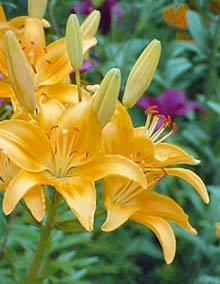
When most gardeners think of bulbs, their minds drift to tulips, daffodils, and hyacinths. Although the flower show of these spring bulbs will soon be finished, there is another group of bulbs that can be planted now for flowers throughout the summer.
Summer bulbs technically include corms, tubers, and rhizomes, as well as bulbs. The beauty of summer-flowering bulbs is their diversity. You can grow gladiolus for cutting, Oriental lilies for bouquets, and dahlias and cannas to fill out a perennial border with color until frost. Not only are the big three summer bulbs ? lilies, dahlias, and gladiolus ? becoming more popular, many other lesser-known, summer-flowering bulbs, such as tuberous begonias and cannas, are experiencing a revival as well.
Sun and Soil
Most summer bulbs grow best in full sun (6 hours) in moist yet well-drained, loose, fertile soil amended with compost. Since most summer bulbs also are heat-loving plants, wait until the ground has warmed to at least 60 degrees F. before planting. If animals, such as voles, are eating the newly planted bulbs, consider placing a handful of crushed oyster shells in each planting hole, or plant the bulbs in a bed lined with chicken wire. Fertilize with a high phosphorus product, such as Bulb Booster, to get the bulbs off to a good start. Mulch bulb beds once they're established to conserve moisture and prevent weed growth.
Lilies
Lilies are considered the queens of the garden. Their majestic flowers can dominate a perennial border, and they also are a long-lived cut flower indoors. Dig the holes 10 to 12 inches deep. Plant the bulbs 4 to 6 inches deep and apart. Lilies are generally hardy in USDA zones 4 to 9. Remove spent flowers, but leave the foliage and as much of the stem as possible to rejuvenate the bulb for next season.
You can extend the flowering season by growing a variety of lily species. Asiatic lilies bloom early to midsummer. They stand 2 to 4 feet tall with upward-facing flowers ranging from red to yellow. Some especially lovely varieties to try are yellow 'Connecticut King' and crimson 'America'.
Following the Asiatic lilies, the trumpet lilies are the next to bloom. These plants grow up to 7 feet tall and produce fragrant flowers in bright colors ranging from yellow to deep purple. Some varieties to try include apricot 'African Queen' and yellow 'Golden Splendor'. Trumpet lilies naturalize well.
The lily show wraps up with the Oriental lilies. These intensely fragrant flowers bloom from midsummer onward. Each 2- to 4-foot-tall plant produces 6 to 12 outward-facing flowers with curled petals. The colors range from white to red. The white 'Casa Blanca' and the pink and white 'Stargazer' are two common varieties. A relatively new hybrid is the Orienpet lilies ? a cross between the Oriental and trumpet lilies. They feature fragrant, upward-facing flowers similar to Oriental lilies, with the more intense flower colors and naturalizing ability of trumpet lilies. 'Shocking' is a red-and-yellow-flowered variety.
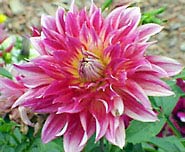 Dahlias
Dahlias
There is nothing subtle about dahlias. The intense colors and huge flowers of many dahlia varieties can dominate a garden. Dig a 6- to 12-inch-deep hole depending on the size of the tuber. Plant tubers 2 to 4 inches deep and 1 to 3 feet apart. Deadhead spent flowers to keep the plants producing blooms until frost. Since dahlias are only hardy to USDA zone 8, in colder regions you'll need to dig tubers after frost has blackened the foliage. Let them dry, then store the tubers in boxes filled with slightly moistened peat moss in a well-ventilated, cool (45 to 55 degrees F.) basement.
"Dinnerplate" dahlias are large, 3- to 4-foot-tall plants with 10- to 12-inch-diameter blossoms. Stake these so they don't flop over in summer. Medium-sized (1 to 2 feet tall) dahlias include "border" and "cactus" types. Diminutive dahlias, such as 'Mignon', grow only 10 to 12 inches tall, but their small, colorful flowers look great in containers.
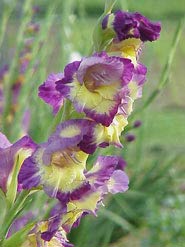 Gladiolus
Gladiolus
Gladiolus produce classic flower spikes in all the colors of the rainbow. These 3- to 4-foot-tall plants are mostly grown as cut flowers. Most are hardy to USDA zone 7, but hardy gladiolus (Gladiolus byzantinus), which produce smaller plants and flowers, are hardy to zone 5.
Plant corms 2 to 6 inches deep (depending on their size) and 6 inches apart. Since gladiolus grow tall, hill the soil around young plants, and stake them when they reach a few feet tall to prevent them from toppling over. Side-dress with a complete fertilizer when plants are 8 to 12 inches tall.
Choose gladiolus varieties based on flower color and shape. 'Rainbow' and 'Butterfly' are two popular mixes. When you cut the flowers, leave at least four leaves on the plant. For the remainder of the summer, keep the plant growing strong until the foliage naturally yellows. In cold areas remove the corms before frost hits, then dig and clean corms, removing the old corm and saving the new one. Store in mesh bags in a well-ventilated, cool (35 to 50 degrees F.) room.
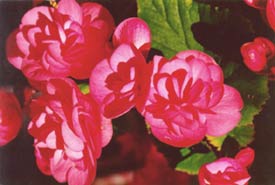 Tuberose Begonias
Tuberose Begonias
Unlike their smaller-flowered cousins, tuberous begonia plants produce 8-inch-diameter, camellia-shaped flowers in colors ranging from white to deep crimson. Tuberous begonias like it cool. They grow best under humid, cool conditions in part shade. While often grown in hanging baskets, they look equally at home in a shady bed in the ground. The frilly 'Double Pastel', the multi-colored 'Picotee', and the new, fragrant 'Scentiment' are some varieties worth trying.
Plant in containers or in the ground 8 to 12 inches apart. Keep the soil moist, but not wet. Tuberous begonias rot easily. Since the tubers are only hardy to USDA zone 9, dig them before a frost and let the tubers dry. Store them in a cool (35 to 45 degrees F.) location in dry peat moss.
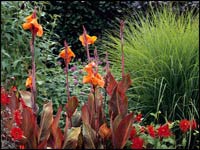 Cannas
Cannas
Cannas are grown both for their bold, yellow, orange, and red spiky flowers and for their sometimes colorful tropical foliage. Varieties such as 'Tropicanna' feature multi-colored, banana-like leaves. The plants of many varieties can reach 10 feet tall, but dwarf varieties, such as 'Ambassador', only stretch to 2 feet. Cannas look great planted in the back of perennial borders, in containers, or along walkways to provide a stately entrance. Because they tolerate moisture, they also grow well near ponds and in wet areas.
Being a West Indies native, cannas need warm soil to grow. Plant rhizomes 4 to 6 inches deep and 2 feet apart. Keep them well watered, and fertilize monthly with a complete fertilizer to support their vigorous growth. Since cannas are only hardy in frost-free areas, after frost kills back the foliage, dig the tubers, and store them in a cool, dark, frost-free place.
 Charlie Nardozzi is an award winning, nationally recognized garden writer, speaker, radio, and television personality. He has worked for more than 30 years bringing expert gardening information to home gardeners through radio, television, talks, tours, on-line, and the printed page. Charlie delights in making gardening information simple, easy, fun and accessible to everyone. He's the author of 6 books, has three radio shows in New England and a TV show. He leads Garden Tours around the world and consults with organizations and companies about gardening programs. See more about him at Gardening With Charlie.
Charlie Nardozzi is an award winning, nationally recognized garden writer, speaker, radio, and television personality. He has worked for more than 30 years bringing expert gardening information to home gardeners through radio, television, talks, tours, on-line, and the printed page. Charlie delights in making gardening information simple, easy, fun and accessible to everyone. He's the author of 6 books, has three radio shows in New England and a TV show. He leads Garden Tours around the world and consults with organizations and companies about gardening programs. See more about him at Gardening With Charlie.